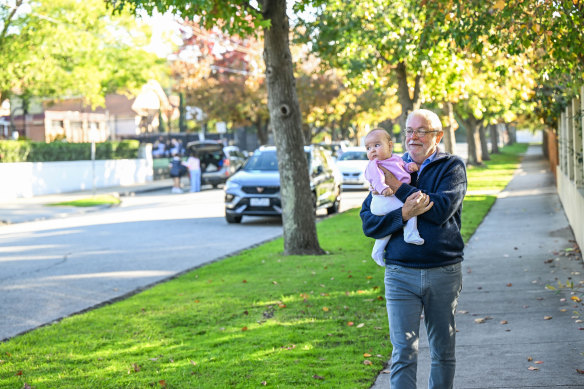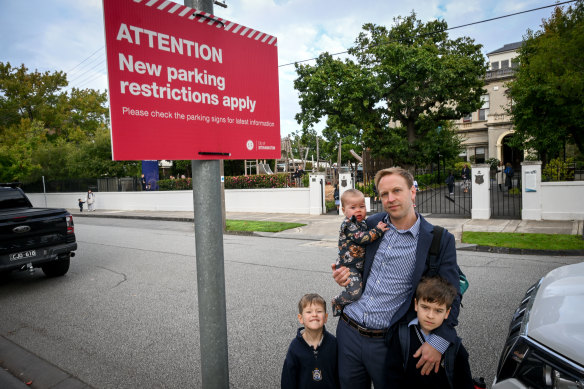By Cara Waters
School is about to start at Caulfield Grammar, and in the Glen Iris streets nearby, all is calm – a big change from the bumper-to-bumper traffic that residents say they have long endured.
During the Easter holidays, areas that were two-hour parking zones in Harold, Willoby and Dorrington avenues were changed to require a permit to park during school drop-off and pick-up times.

Michael Coates and his granddaughter at school drop-off time on Tuesday morning near Caulfield Grammar in Glen Iris. Credit: Joe Armao
Parents were “absolutely livid” after Stonnington Council made the changes, which they said forced them to park streets away and walk their children to school. Residents, however, could not be happier.
“At this stage, it is a qualified success,” Michael Coates said. “Just standing out there at school pick-up time, it was very relaxed and casual and remarkably peaceful.”
Coates, who has lived next to Caulfield Grammar’s early learning to grade 6 Malvern campus, for more than 30 years, said that before the parking was changed the roads were chaotic.
Traffic was limited to one way because cars were parked on either side of the street – and sometimes across residents’ driveways – he said.
“There’s five-minute parking allowed across the road from us and that’s ample time, we think, for parents to park the car [and] quickly drop off their child,” he said.
“The busy parents, this isn’t a problem for. The parents who want to hang around and socialise – of course, they’re inconvenienced because they were hogging the car spaces.”
While parents stress that Caulfield Grammar has been around for more than 100 years, residents say the school has changed significantly in the time they have lived there.
“It was effectively a local school,” Coates said. “It was not a big business like this school is now, and it had a different culture.”
Coates estimates that since 1994, student numbers at the school have increased 60 per cent and staff numbers 300 per cent. Caulfield Grammar declined to comment on student numbers.
“There’s no doubt that most of the students don’t live locally,” Coates said. “Anecdotally, I would say there has been a massive increase in the number of kids being driven to school.”
According to data collected last July, private schools in the eastern suburbs have some of the most congested drop-off and pick-up zones in Melbourne.
Another resident, who asked not to be named because he feared a backlash from the school, said nearby Sacre Coeur and Korowa had invested heavily to provide space for parking while Caulfield Grammar had not.
“Of three private schools on this block, two have decided to take ownership and invest and one has not,” he said. “Caulfield Grammar has not invested ... effectively, they don’t want vehicles on their campus.”
Caulfield Grammar principal Ashleigh Martin declined to comment on the school’s responsibility for providing parking or a drop-off zone on-site.
“In our discussions with the City of Stonnington, we are reiterating a request to explore previously tabled traffic management options that reduce risk for all community members,” he said. “We look forward to contributing to a respectful discussion with all stakeholders over the coming weeks as, together, we seek to arrive at a fair and sensible solution.”
A spokeswoman for the City of Stonnington said the council was monitoring the trial restrictions and their effect on traffic and parking in the area.
“The changes were made following long-standing transport and parking concerns raised by the community and residents,” she said. “This included safety concerns due to the road becoming congested at drop-off and pick-up times and restricted access to emergency services including police, fire and ambulance.”
The spokeswoman said the council was working with Caulfield Grammar, and encouraged the school to consider establishing a drop-off facility within its grounds.
But parent Daniel Foley said the parking changes were having a negative impact on parents who had to park further away.
Foley said that with a four-year-old child who attended kindergarten at Caulfield Grammar and had to be taken to the classroom, a five-minute parking time was not helpful.
“It’s physically impossible to park there, get your kid into class and then back to the car,” he said.

Parent Daniel Foley with sons William 7, Alfred, 4, and nine-month-old daughter Annabel.Credit: Eddie Jim
Foley said the changed restrictions had simply moved the parking issues into the surrounding streets.
“Residents that bought houses in a street with a school on it knew what they were buying,” he said.
Start the day with a summary of the day’s most important and interesting stories, analysis and insights. Sign up for our Morning Edition newsletter.